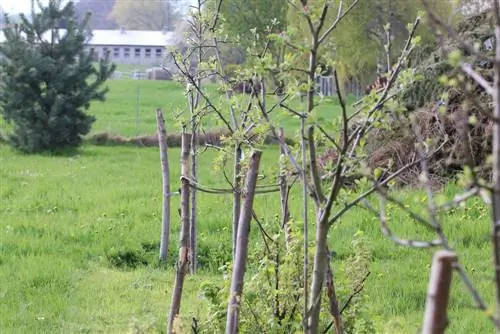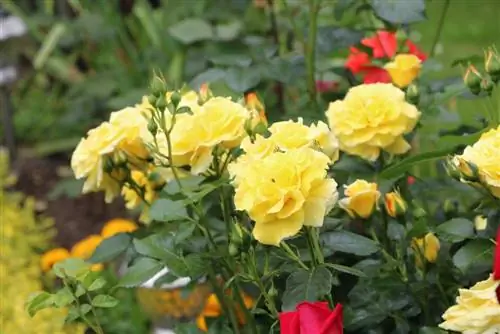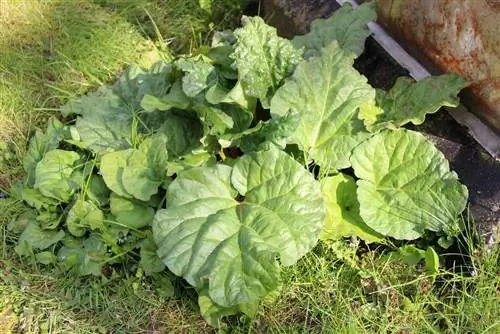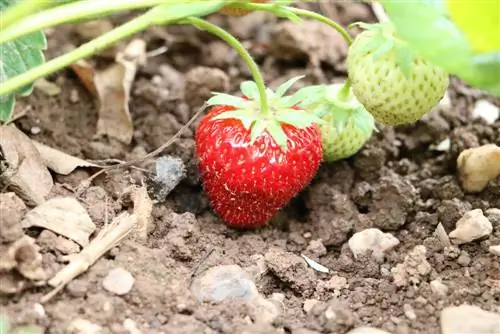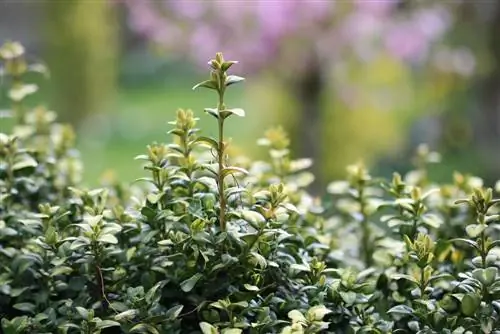- Author admin [email protected].
- Public 2023-12-17 03:39.
- Last modified 2025-01-24 12:45.
Due to their sometimes enormous height, trees occupy a special position in the garden and not least among all the plants. They tower over almost everything and become the central eye-catcher. The most common example is the traditional house tree with special symbolic power. There are trees with different leaf shapes and colors, with long pointed needles as well as evergreens and deciduous ones. Planting is mainly done in autumn and spring. When is the best time to plant depends on various factors, including sensitivity to frost.
Factors affecting planting time
Not every tree can be planted at every time of the year. Only if they are planted at the right time do they have the best conditions to grow and thrive optimally. The best possible time to plant depends on different circumstances.
- The most important point is the condition of the root ball
- Planting times depend on whether it is bare root, baled or containerized
- Differences also exist in evergreen and deciduous trees
- Frost hardness of the tree species in question is a factor that should not be ignored
- Winter hardiness largely depends on the region and climatic conditions
In principle, trees should preferably be planted in the time when there is no vegetation, i.e. in autumn, although for most people planting in both autumn and spring is possible. The ground should definitely be frost-free. An exception are trees that are more sensitive to frost, such as the Judas tree, a fantastically beautiful house tree for which spring is the better time to plant.
Limited planting time for bare root produce
Almost exclusively deciduous or deciduous species are offered as bare-root products. These can be fruit trees such as apples, pears and cherries as well as species that require more warmth such as apricots, nectarines or peaches. By the way, the apple tree is also very popular as a house tree. Bare-rooted plants, as the name suggests, are sold without a ball of soil. This makes them particularly susceptible to dehydration.
As a result, these bale qualities in particular should be planted as soon as possible after purchase. If this is not possible and interim storage is necessary, this should be as short as possible and the roots should not dry out during this time. It is best to store them away from sun, drafts and frost.
A bare-root tree can usually be planted after the leaves have fallen in autumn, around mid-October to early December, and depending on the weather in early spring around March to April. The soil should definitely be frost-free at the time of planting. Both fall and spring planting can reduce the risk of frost or drought damage. Nevertheless, it is recommended to plant preferably in autumn.
Planting times for baled goods
So-called baled goods grow outdoors and are generally more robust and stronger. In contrast to bare-root plants, it is offered with a ball of earth. Digging them up in the nursery initially weakens the plants because, despite all the care, their roots are damaged. But the whole thing also has advantages, because standing out forces the plants to form new roots, which are particularly vital and grow well into the soil, provided they are planted promptly.

In addition, with these plants grown outdoors there is no risk that their roots are neither matted nor grown in circles, as can be the case with potted ones. Planting time for frost-hardy evergreen deciduous trees and coniferous trees with earth balls is during their natural rest period from October to March, and depending on the weather also sometimes in the months of September and April.
They should be in the ground by the end of April at the latest. The best months for planting are October and November, and September for conifers. In contrast to deciduous trees, evergreens evaporate a lot of water even in winter and should therefore be rooted before the ground freezes.
Planting container plants all year round
- Container plants can basically be planted all year round
- Assuming they were raised in the pot in which they are sold
- The root system must have developed inside this pot
- The exception when planting container plants is periods of ground frost
- Year-round planting is not always advantageous
For example, a tree that is taken out of the pot in summer and placed in warm, dry soil has a much harder time growing than one that is planted at normal planting times in autumn or spring.
Tip:
Poted plants offered in stores are not necessarily container plants, as specimens planted in the field are often placed in a pot before sale for reasons of stability and appearance.
Classic fall planting
Classic planting time, especially for hardy trees, is the time of vegetative rest. It starts in September and ends at the end of April. It is only interrupted by the frost period. Now all trees can be planted that are not sensitive to frost, such as cherries, plums or apples, a possible candidate as a house tree.
It doesn't matter whether it is bare root, baled or container goods. Evergreen deciduous and coniferous trees react particularly positively to early autumn planting. Even though many trees have now lost their foliage and look as if they are in the deepest phase of dormancy, their roots are still active and can easily anchor themselves in the soil before the first frosts appear.
Advantages
The planting season begins in autumn. Autumn as a planting time best adapts to the natural rhythm of the plants. Around September 23rd, plants begin to prepare for winter dormancy. They extract nutrients from the leaves and store them in their roots, which is reflected in the colorful autumn leaves. The leaves eventually fall off while the roots become even more active. Planting at this time has clear advantages over spring planting.
- The still relatively warm soil makes it easier for trees to grow
- Plants can still form many fibrous or fine roots before winter
- This makes it easier for them to absorb water, nutrients and oxygen in spring
- Winter wetness also ensures good contact between the roots and the soil
- Vacities in the soil created during planting are closed
- This reduces the risk of drying damage in spring
- Plant selection in nurseries or garden shops is largest in autumn
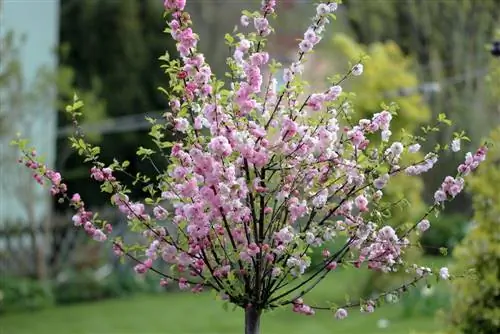
Woods planted in autumn practically have a developmental advantage over those planted in spring, which benefits them when new growth occurs. In addition, there is a significantly lower care and supply effort, which is many times higher in spring and summer.
Tip:
The time between purchasing and planting the trees should always be as short as possible, which is one hundred percent the case when planting in autumn.
Spring planting
Buying and planting in spring, between March/April and May, is particularly suitable for trees or trees that are generally more sensitive to frost, or especially in the first few years. These include, among others, nectarine, apricot, peach, red or hornbeam, laurel cherry but also a wintergreen magnolia or coniferous trees such as the yew. In spring, freshly planted trees, especially unusually high temperatures combined with drought, cause problems. Plants that have not yet developed fine roots at this point are now suffering from enormous stress.
In addition, deciduous trees now have to develop new shoots, leaves and flowers in addition to roots, which requires a lot of energy from them. Nevertheless, spring remains the better planting alternative for sensitive trees because it offers better protection against drought damage caused by frost. In addition, they are not exposed to autumn or winter storms during this time and there is no risk of stress cracks due to strong temperature fluctuations. However, the care requirement, especially when it comes to water requirements, is slightly higher than in autumn.
Conclusion
When it comes to planting deciduous, coniferous and fruit trees, autumn is without a doubt the best time. It doesn't matter whether the trees are bare root, baled or containerized, nor whether they are evergreen or summergreen trees. On the other hand, it is still better to plant more sensitive trees in spring. Even if the care required is a little higher, the young trees thank you with strong growth, lush flowers or a variety of delicious fruits. Because not only a symbolic house tree should grow and thrive over many years and maintain its very special appearance.

